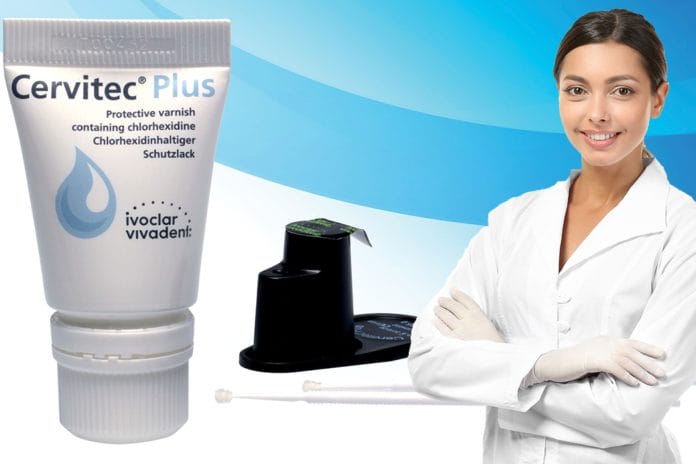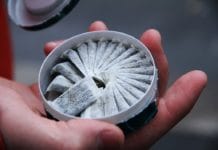Disclosure: This article is sponsored by Ivoclar Vivadent as part of our sponsored partner program.
When hygienists hear the word chlorhexidine, many may automatically think of chlorhexidine gluconate rinse; with that comes the thought of stain, calculus build-up, inhibition of fibroblasts (which can impair healing), and taste alterations. While these are downfalls for chlorhexidine gluconate rinses, the same does not hold true for chlorhexidine diacetate varnish. Further, chlorhexidine diacetate varnish has more indications for use beyond just bacterial reduction like chlorhexidine gluconate rinse.
What is Cervitec Plus Chlorhexidine Varnish?
Cervitec Plus is a Chlorhexidine protective varnish. In 1993, the initial Cervitec product was made available to the public for the purpose of:
- Protecting exposed tooth root surfaces
- Treating sensitive teeth
- Reducing bacterial activity on the surface of the teeth
Cervitec Plus was released a number of years later, providing improved adhesion over the original product, which enhances its ability to provide desensitization of teeth. The varnish component is dissolved into a neutral mixture of ethanol and water, making it hold up better to moisture during the application.1
Cervitec Plus contains 1% chlorhexidine diacetate and 1% thymol as the active ingredients. Once Cervitec Plus varnish is applied and has dried, it contains approximately 10% of chlorhexidine and 10% of thymol. Thymol, like chlorhexidine, has an antimicrobial effect as it is an essential oil of thyme. Thymol is also effective against fungus (fungistatic), like yeasts. It is efficacious based on its ability to denature proteins and destruct cell membranes.1
Cervitec Plus is applied supragingivally affecting biofilm. Unlike chlorhexidine rinses, it does not come in contact with fibroblast cells and therefore does not inhibit healing and reattachment. Cervitec Plus also does not stain, cause taste impairment, or increase calculus build-up, as chlorhexidine gluconate rinses often do.
Cervitec Plus vs. Chlorhexidine Oral Rinses
Chlorhexidine oral rinse has long been the go-to for many dental professionals. However, many patients balk at these rinses due to the unpleasant taste, taste alterations, and the staining of teeth, tongue, and restorations. By eliminating the unpleasant taste and reducing the staining experienced with oral rinses, Cervitec Plus provides an excellent alternative that can be used for patients of all ages. Some of the other benefits of using Cervitec Plus instead of a chlorhexidine oral rinse include:
- Patients don’t have to worry about rinsing at home. They simply go to their dentist once every 90 days for application of Cervitec Plus on their teeth and the product continues to work for up to three months.
- The application is quick and easy and the product can be applied precisely where it is needed. This is particularly useful when applying the product to young children who are not likely to stay still for very long.
- The powerful combination of chlorhexidine and thymol are provided in a single application.
- The varnish dries clear, meaning that patients can leave the dental office and go about their day without worrying that everyone knows they just had dental treatment.
- Ensures quality of dental work – including crowns, bridge-work, and implants – due to the product’s neutral pH (6.5-7)1, by targeting biofilm and not affecting the oxide layer of implants.
- Film is less noticeable to patients than fluoride varnishes.
Indications for Use
Cervitec Plus chlorhexidine varnish is indicated for the protection of exposed root surfaces and the treatment of hypersensitive cervicals. A third off-label use, similar to how fluoride varnish is used off-label to prevent caries, is the reduction of bacterial activity on tooth surfaces. This makes it ideal for use as an adjunct to non-surgical periodontal therapy (SRP) and periodontal maintenance, around orthodontic bands, erupting teeth, around prosthetic restorations, implant maintenance, and as the last step of restorative procedures to ensure the quality of the restoration.
Dentinal Hypersensitivity and Protection of Exposed Root Surfaces
Currently, there are two approaches to treating dentinal hypersensitivity based on the hydrodynamic theory. One approach is sealing dentinal tubules to prevent movement of fluid, and the other is inhibiting the neuronal transmission of the stimuli. The mechanism of action for Cervitec Plus is sealing open dentinal tubules1 and reducing the permeability of dentin2.
In clinical studies comparing the use of Cervitec Plus and the original Cervitec, it was found that both products offered relief from tooth hypersensitivity and that the effects on hypersensitivity were already noticeable one day after application. A significant improvement in hypersensitivity was experienced by the users of both products within one week. However, the effectiveness of the original product began to decrease within three months, while users of Cervitec Plus noticed no difference in the quality of protection after this amount of time had passed.1,2
The prevalence of root caries increases with age, due to gingival recession because of periodontal disease, traumatic occlusion, as well as use of medications that reduce the amount and quality of salivary flow. Multiple tests have indicated that Cervitec is effective in reducing the number of lesions and root caries in senior adults, including those with extended crowns and other dental work.1,11-13
Off-Label Uses for Cervitec Plus
The U.S. Food and Drug Administration has approved the labeled use of Cervitec Plus for protection of exposed roots and the treatment of tooth hypersensitivity. However, there are other scientifically-proven, off-label uses for the product. In particular, it is used by dental professionals to reduce bacterial activity on the teeth, implants, and around restorations. Reducing bacterial activity results in the elimination of biofilm buildup and lowering the risk of decay. Some of the specific bacteria that the product is found to inhibit includes1:
- Streptococcus mutans: A cariogenic bacteria that is the leading cause of tooth decay.
- Streptococcus sobrinus: Another cariogenic bacteria that frequently leads to caries.
- Actinomyces naeslundii: One of the first bacteria to colonize on the tooth surface, it is implicated in periodontal disease.
- Candida albicans: A pathogenic yeast found in the human gut and mouth of 40-60 percent of healthy adults. It is the most common culprit of fungal infections.
Numerous studies have revealed the benefits of Cervitec Plus for reducing bacterial activity. Some of those results include:
Caries and S. mutans reduction in children and infants
- A two-year Turkish study on 11-13 year old adolescents with a high caries risk found that, after 12 months, the youth that had been treated with Cervitec showed a statistically significant reduction in the presence of the bacteria mutans over those who were treated with a sodium fluoride gel and those who were treated with dental education and the provision of fluoride-containing toothpaste.1,14
- A study of 33 15-year-old children involved applying Cervitec or a placebo to interdental spaces in a split-mouth method over two-day intervals. Both the placebo and Cervitec produced an immediate reduction in bacteria. However, testing at day 8, 30, and 90 revealed that only Cervitec produced a significant reduction in mutans counts in the saliva. This shows that Cervitec can inhibit the recolonization of bacteria in interdental spaces for a sustained period of time.1,15
- A study of 32 adolescents were treated in split-mouth format with Cervitec and a placebo, with examinations taking place every 12 weeks. Studies showed that the presence of fissure caries significantly increased with the placebo but did not with Cervitec.1,17
- Cervitec has been found to be effective when used on very young children – even some as young as one year old – in reducing caries caused by mutans.1,21
Transfer of S. mutans from mother to children
- A 2005 study involved applying Cervitec to 97 pregnant women at regular intervals until their children reached the age of 36 months. The study revealed that the children whose mothers were treated had significantly fewer early childhood caries than the children of the 60 mothers in the control group who were not treated.1,19
- A study investigated the transfer of mutans to children in their first two years of life, demonstrated a lowered incident of caries and plaque and healthier gingiva compared to the control group. Further, the prenatal and postnatal applications of Cervitec prevented the transmission of measurable amounts of S. mutans from mothers to their children.1,20
Orthodontic patients
- A study of adolescents with fixed orthodontic appliances revealed a reduction in mutans through the use of Cervitec. This blind, split-mouth study consisted of the application of Cervitec as well as a placebo varnish. The reduction in bacteria was observed after seven days, along with the reduction of lactic acid produced by the bacteria.1,22
- Cervitec Plus has also been found to be effective in preventing caries in patients with fixed orthodontic appliances. One such study revealed that 90 percent of the patients – all adolescents undergoing orthodontic treatment – were in a high-risk class of developing caries, that class was reduced to 40 percent with the application of Cervitec. The authors of the study also noted no discoloration using Cervitec, unlike the use of CHX-containing rinse and gel used in the study.1,24
- A 6-month study of 198 adolescents showed when Cervitec is applied before brackets are bonded, the number of S. mutans was significantly lower at five months after bonding than in the control group treated with a fluoride varnish.1,23
- Research looking into patients with orthodontics and gingivitis showed 30 days after the application of Cervitec, a decrease in gingival inflammation and bleeding resulted. Further, the gingival cervicular fluid showed a significant decrease of concentration of the inflammatory mediator PGE2.1,25
Adjunct to non-surgical periodontal therapy (SRP)
- In a split-mouth, randomized study, 25 subjects suffering from generalized, chronic periodontitis showed, in conjunction with scaling and root planing, the application of Certivec Plus increased clinical attachment level at 1- and 3-month post-treatment.3
- A clinical study conducted in 11 patients suffering from chronic periodontitis through a split-mouth design showed non-surgical periodontal therapy (SRP) in conjunction with the use of Cervitec Plus improved plaque index, bleeding on probing, pocket depth, and clinical attachment than SRP alone at 1 and 3-months post-treatment. A greater reduction in the total anaerobic count at 1- and 3-months was found in the Cervitec Plus treated group as well.6
- A statistically significant reduction in plaque index, sulcus bleeding index, and attachment level were found at the 1- and 3-month post-treatment mark of 30 patients studied with chronic periodontitis when Cervitec Plus was used as an adjunct.9
Implant maintenance
- Cervitec was placed in healing caps for implants and compared to a control of non-treated healing caps. The study found the non-treated healing caps were substantially colonized with various types of bacteria, while the Cervitec-treated healing caps showed very little bacterial colonization.1,26
- aureus is capable of over overcoming the gap between a crown and implant; this colonization can result in peri-implantitis, which can result in implant failure. Research showed when sealed with Cervitec, S. Aureus was not detected when incubated for three to eleven weeks inside the implant surface, unlike the control group.1,4
In Conclusion
From reducing white spot lesions in orthodontic patients to increasing healing in periodontitis patients, chlorhexidine-containing Cervitec Plus varnish has several benefits. These benefits can prevent disease and treat patients from our youngest pediatric patients to our patients in their golden years without the side effects of chlorhexidine rinse.
To learn more about Cervitec Plus, visit https://www.ivoclarvivadent.com/en/p/all/products/prevention-care/bacteria-control/cervitec-plus
References
- Fischer, K., Sbicego, S. Scientific Documentation Cervitec® Plus. Ivoclar Vivadent AG: Research and Development, Scientific Services. 2010 Aug.
- Drebenstedt, S., Zapf, A., Rodig, T., et. al. CHX-Containing Desensitizers: A Controlled Double-Blind Study. Operative Dentistry. 2012; 37-2: 161-171.
- Anand, V., Govila, V., Gulati, M., et. al. Chlorhexidine-thymol Varnish as an Adjunct to Scaling and Root Planing: A Clinical Observation. Journal of Oral Biology and Craniofacial Research. 2012 May-Aug; 2(2): 83-89.
- Besimo, C., Guindy, J., Lewetag, D. Meyer, J. Prevention of Bacterial Leakage into and from Prefabricated Screw-Retained Crowns on Implants in Vitro. The International Journal of Oral & Maxillofacial Implants. 2000; 14(5): 654-660.
- Geroge, M.A., Kalangi, S.K., Vasudevan, M., Krishnaswamy, N.R. Chorhexidine Varnishes Effectively Inhibit Porphyromonas gingivalis and Streptococcus mutans – An in Vivo Study. Journal of Indian Society of Periodontology. 2010; 14(3): 178-180.
- Manikandan, D. Balaji, V.R., Niazi, T.M., et. al. Chlorhexidine Varnish Implemented Treatment Strategy for Chronic Periodontitis: A Clinical and Microbial Study. Journal of Pharmacy and BioAllied Sciences. 2016 Oct; 8(Suppl 1): S133-S137.
- Patel, P.M., Hugar, S.M., Halikerimath, S., et. al. Comparison of the effect of Fluoride Varnish, Chlorhexidine Varnish and Casein Phosphopeptide- Amorphous Calcium Phospate (CPP-ACP) Varnish on Salivary Streptocuccus mutans Level: A Six Month Clinical Study. Journal of Clinical and Diagnostic Research. 2017 Aug; 11(8): ZC53-ZC59.
- Okada, E.M.P., Ribeiro, L.N.S., Stuani, M.B.S., et. al. Effects of Chlorhexidine Varnish on Caries during Orthodontic Treatment: A Systemic Review and Meta-analysis. Brazilian Oral Research. 2016; 30(1): e115.
- Sachdeva, S. Grover, V., Malhotra, R., et. al. Comparison of Clinical Effectiveness of Single and Multiple Applications of 1% Chlorhexidine Varnish (Cervitec Plus) along with Scaling and Root Planing in Patients with Chronic Periodontitis. Indian Society of Periodontology. 2018 Nov-Dec; 22(6): 523-528.
- Silla, M.P., Company, J.M.M., Silla, J.M.A. Use of Chlorhexidine Varnishes in Preventing and Treating Periodontal Disease: A Review of the Literature. Med Oral Patol Oral Cir Bucal. 2008 April; 13(4): E257-60.
- Sanderink, R. Bernhard, H. Knoke, M., et. al. Curriculum – Orale Mikrobiologie und Immunologie. Quintessenz; Berlin; 2004.
- Crailsford, S.R., Fiske, J., Gilbert, S., et. al. The Effects of the Combination of Chlorhexidine/Thymol- and Fluoride-containing Varnishes on the Severity of Root Caries Lesions in Frail Institutionalised Elderly People. J Dent. 2002; 30: 319-342.
- Baca, P. Clavero, J. Baca, A.P., et. al. Effect of Chlorhexidine-thymol Varnish on Root Caries in a Geriatric Population: A Randomized Double-blind Clinical Trial. J Dent. 2009; 37: 679-685.
- Ersin, N.K., Eden, E., Eronat, N., et. al. Effectiveness of 2-year Application of School-based Chlorhexidine Varnish, Sodium Fluoride Gel, and Dental Health Education Programs in High-risk Adolescents. Quintessence Int. 2008; 39: e45-51.
- Petersson, L.G. Maki, Y., Twetman, S., Edwardsson, S. Mutans streptococci in Saliva and Interdental Spaces after Topical Application of an Antibacterial Varnish in Schoolchildren. Oral Microbiol Immunol. 1991; 6: 284-287.
- Bratthall, D. Serinirach, R., Rapisuwon, S., et. al. A Study into the Prevention of Fissure Caries Using an Antimicrobial Varnish. Int Dent J. 1995; 45: 245-254.
- Skold-Larsson, K., Fornell, A.C., Lussi, A., Twetman, S. Effect of Topical Applications of a Chlorhexidine/Thymol-containing Varnish on Fissure Caries Assessed by Laser fluorescence. Acta Odontol Scand. 2004; 62: 339-342.
- Baca, P., Munoz, M.J., Bravo, M., et. al. Effectiveness of Chlorhexidine-thymol Varish for Caries Reduction in Permanent First Molars of 6-7-year-old Children: 24-month Clinical Trial. Community Dent Oral Epidemiol. 2002; 30: 363-368.
- Dubielecka, M. Slotwinska, S.M. Suppression of Caries in Mothers and Caries Risk in Offspring. J Dent Res. 2005; 84 (Spec Iss B): Abstract #0068.
- Duskova, J., Broukal, Z. Kratky, M. Inhibition of the Oral Steptococcus mutans – Transfer in the Mother and Child Care: Results in Mothers and Infants in the 3rd Year of Study. Caries Res. 2000; 34: 347.
- Plotzitza, B. Kneist, S. Berger, J., Hetzer, G. Efficacy of Chlorhexidine Varnish Applications in the Prevention of Early Childhood Caries. Eur J Paediatr Dent. 2005; 6: 149-154.
- Madlena, M. Vitalyos, G. Marton, S. Nagy, G. Effect of Chlorhexidine Varnish on Bacteria Levels in Plaque and Saliva during Orthodontic Treatment. J Clin Dent. 200; 11: 42-46.
- Ogaard, B. Larsson, E., Glans, R. et. al. Antimicrobial Effect of a Chlorhexidine Varnish (Cervitec) in Orthodontic Patients. A Prospective, Randomized Clinical Trail. J Orofac Orthop. 1997; 58: 2016-2013.
- Kneist, S., Zingler, S., Lux, C. Therapiebegleitende Massnahmen zur Kontrolle des Karies- und Demineralisationsrisikos bei kieferorthopädischer Behandlung. ZWR Das deutsche Zahnärzteblatt. 2008; 117: 218-228.
- Sköld, K., Twetman, S., Hallgren, A., et al. Effect of a Chlorhexidine/thymol-containing Varnish in Prostaglandin E2 Levels in Gingival Crevicular Fluid. Eur J Oral Sci. 1998; 106: 571-575.
- Johansson, L.A., Ekfeldt, A., Petersson, L.G., Edwardsson, S. Antimicrobial Effect of a Chlorhexidine Varnish, Cervitec in Healing Caps in Osseointegrated Prosthetic Treatment. Swed Dent J. 1994; 16: 255-256.










